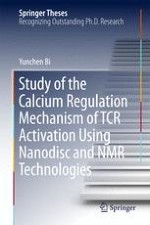2018 | OriginalPaper | Buchkapitel
2. Lipid Molecular-Ion Interaction Study Based on Nanodisc
verfasst von : Dr. Yunchen Bi
Erschienen in: Study of the Calcium Regulation Mechanism of TCR Activation Using Nanodisc and NMR Technologies
Verlag: Springer Berlin Heidelberg
Aktivieren Sie unsere intelligente Suche, um passende Fachinhalte oder Patente zu finden.
Wählen Sie Textabschnitte aus um mit Künstlicher Intelligenz passenden Patente zu finden. powered by
Markieren Sie Textabschnitte, um KI-gestützt weitere passende Inhalte zu finden. powered by
